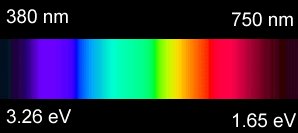 |
What band gaps of which type would we
like to have for III-V properties? |
|
 |
We want to cover regular optics, meaning whatever one can do with visible
light. The human eye can perceive wavelengths from 750 nm or 1.65 eV (= red) to 380 nm or 3.26
eV (= violet) |
| |

Visible
spectrum as far as it can be
reproduced on a screen. |
|
|
 |
So we like to have semiconductors with a direct band gap
and with every conceivable band gap energy between 1.65 eV and 3.26 eV |
|  |
We also know that infra
red (IR) optics is important - at the very least for communication via optical
fibres. This happens at a wavelength of about 1 500 nm or an energy of about 0.83 eV. This means that
we would also like to commandeer direct semiconductors with band gaps ranging from 1.65
eV down to at least 0.8 eV. |
|
 |
Moreover, we know that there is not only a lot of demand for white
light but that there are already "white" LED's in, e.g., flashlights and car headlights. The easiest
way to make white light out of monochromatic light (that we will always get from a LED) is to produce ultraviolet light (UV) that is converted to white light via some intermediate fluorescent material
like in any "fluorescent" lighting fixture. This means that we also want to have direct
semiconductors with band gaps ranging from 3.26 eV up to ??? - well. at least 4 eV. |
|
 |
Summing up: We need to have direct
semiconductors with band gaps ranging from 4eV - 0.8 eV |
 |
What are the requirements for substituting light bulbs by LED's? What is the state of the art? |
|
 |
First we remember: "Light "bulbs", i.e. lighting fixtures already do exist in many variants.
If we want to replace what has been around for more than a century, we must be cheaper
or better. We can be if we look at the weak points of existing "standard"
lighting with some kind of "bulbs" where light is produced because something is very hot.
- LED's can have much better efficiencies, i.e. you get more light per Watt.
- LED's can have a much larger lifetime, i.e. you change them after 10 years instead of after just a (felt)
few months.
|
|
 |
The problem is to have high power (not the same as high efficiency) and all colors. |
|  |
State of the art: Look in the Internet and you see: LED lighting is just now starting to replace
conventional lighting in special applications. It is expected to go far in replacing general lighting in the next 10
years or so. |
 |
Amend and discuss - the list of optoelectronic
products |
|
 |
The most important optoelectronic products besides LED's are:
- Semiconductor Lasers. No bar-code reader, CD or DVD or whatever
comes next without them.
- Optical sensors. The output of the fibre optic cable spanning the Pacific or Atlantic
is modulated light. Something must convert it back into modulated voltage.
- Displays. Large display boards, e.g. on Times Square in Mamhatan, consistof
hundred thousands of individual LED's. Small display in your cell phone or (soon) TV screens consist of millions
of integrated
organic LED's in an OLED display.
|
| |
| |
© H. Föll (Semiconductor Technology - Script)
